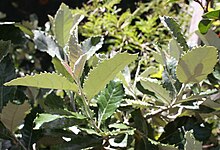Brachylaena is a genus of flowering plants in the aster, or composite, family, Asteraceae or Compositae. Several are endemic to Madagascar, and the others are distributed in mainland Africa, especially the southern regions.[3]
| Brachylaena | |
|---|---|

| |
| Branches of Brachylaena discolor | |

| |
| Inflorescences of female Brachylaena huillensis plant | |
| Scientific classification | |
| Kingdom: | Plantae |
| Clade: | Tracheophytes |
| Clade: | Angiosperms |
| Clade: | Eudicots |
| Clade: | Asterids |
| Order: | Asterales |
| Family: | Asteraceae |
| Tribe: | Tarchonantheae |
| Genus: | Brachylaena R.Br. |
| Species | |
|
See text | |
| Synonyms[1][2] | |
| |
These are trees and shrubs with alternately arranged leaves. One of these, Brachylaena merana, is the tallest of all composites ('daisy trees") at up to 132 feet (forty meters).[4] and Brachylaena huillensis of East Africa is of similar height. They are dioecious, with male and female flowers occurring on separate individuals. The flower heads are somewhat disc-shaped. Heads with female flowers are larger and produce larger pappi.[5]
B. huillensis is the only widespread species,[3] growing as a dominant tree in Brachylaena woodlands and a common species in some eastern African forests. It provides critical habitat for many animal species. It is also sought after for its wood and has been overexploited.[6]
- Species[2]
- Brachylaena discolor DC.
- Brachylaena elliptica Less.
- Brachylaena glabra (L.f.) Druce
- Brachylaena huillensis O.Hoffm. – lowveld silver-oak, muhuhu
- Brachylaena ilicifolia (Lam.) E.Phillips & Schweick.
- Brachylaena merana Humbert
- Brachylaena microphylla Humbert
- Brachylaena neriifolia (L.) R.Br.
- Brachylaena perrieri Humbert
- Brachylaena ramiflora Humbert
- Brachylaena stellulifera Humbert
- Brachylaena uniflora Harv.
Some species are subject of dispute:
- Brachylaena rotundata S.Moore is seen by some as Brachylaena discolor var. rotundata (S.Moore) Beentje[2]
- Brachylaena transvaalensis Hutch. ex E.Phillips & Schweick. is seen as synonym of Brachylaena discolor var. transvaalensis (E.Phillips & Schweick.) Beentje[2]
References
edit- ^ Flann, C (ed) 2009+ Global Compositae Checklist
- ^ a b c d "Brachylaena R.Br". Plants of the World Online. Royal Botanic Gardens, Kew. Retrieved 15 August 2022.
- ^ a b Beentje, H. J. (2000). The genus Brachylaena (Compositae: Mutisieae). Kew Bulletin 55(1), 1-41.
- ^ Carlquist, Dr. Sherwin. Island Biology. New York & London: Univ. of Columbia Press. p. 419.
- ^ Hyde, M. A., et al. (2013). Brachylaena. Flora of Zimbabwe.
- ^ Cordeiro, N. J. and M. Githiru. (2000). Conservation evaluation for birds of Brachylaena woodland and mixed dry forest in north-east Tanzania. Bird Conservation International 10(1), 47-65.